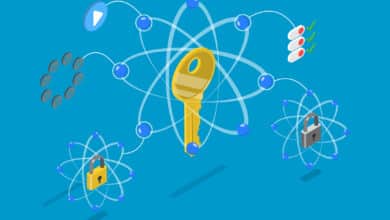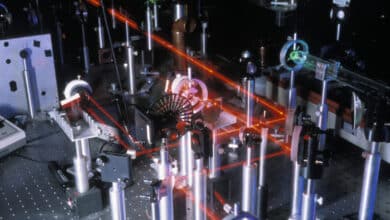Quantum Computers Intro

Table of Contents
Introduction
I remember the first time I heard the phrase “quantum computer” about a ten years ago. I pictured something out of a sci-fi movie – maybe a glowing box humming with mystical power. As a techie who spends a lot of time worrying about encryption and security, my skeptical eyebrow immediately went up. Quantum anything has a way of making people lose their minds a bit (even perfectly sane engineers). Headlines have proclaimed that quantum computers will instantly break all our codes, shatter SSL, and basically knock down the financial system as we know it.
It sounds wild, and to be fair, quantum computing is pretty wild, but let’s take a deep breath and have a down-to-earth chat about what quantum computers really are, and why they could one day crack our cryptography. But not just yet.
Bits vs. Qubits: A Quantum 101
First, what the heck is a quantum computer anyway, and how is it different from the trusty classical computers we deal with every day? It all comes down to the basic unit of information. In a normal computer, the smallest unit is a bit, which can hold a value of either 0 or 1 – like a light switch that’s either off or on. A quantum bit, or qubit, is the quantum analogue of the bit. But qubits don’t play by the same rules as ordinary bits. Instead of being stuck as a 0 or 1, a qubit can exist in a superposition of 0 and 1 at the same time! Think of a qubit like a magical coin that you spin on a table: as it whirls, it’s not just heads or tails – in a sense, it’s a kind of blend of both until you stop it. In quantum-speak, while that coin (qubit) is spinning, we say it’s in a superposition of the two states. Only when you measure it (i.e. catch the coin) do you get a definite heads or tails (i.e. 0 or 1). Upon measurement, the qubit collapses to either 0 or 1 with some probability for each. In other words, you can exploit the uncertainty by not looking at the qubit until you’ve done some computations with it – that’s where the quantum magic begins.
But wait, there’s more weirdness. Qubits can also exhibit something called entanglement, which Albert Einstein famously dubbed “spooky action at a distance” (he wasn’t exactly handing out compliments). Quantum entanglement is a phenomenon where the state of each particle (or qubit) cannot be described independently of the others – they become linked, even across space. If you have two entangled qubits, it’s like they become twins with a psychic connection: perform a measurement on one, and the other instantly reflects a correlated result, no matter if it’s in the same lab or on the other side of the planet. It’s bizarre, counterintuitive, and completely real (as countless experiments have confirmed). For quantum computers, entanglement is crucial because it allows qubits to coordinate their “spooky” states and work together in ways classical bits simply can’t.
The Promise: Massive Parallelism (in Theory)
Alright, so qubits can be 0 and 1 at the same time, and multiple qubits can even be entangled in complicated ways. Why do we tech folks get excited about that? One word: parallelism – exponential parallelism, to be exact. If you have n classical bits, they can only represent one out of 2n possible combinations at any given moment. For example, 4 classical bits can hold one specific value out of 24 = 16 possibilities (like “0011” or “1010”), and if you want to try a different combination, you have to explicitly change those bits. But a register of 4 qubits can effectively be in all 16 of those states at once due to superposition. In general, n qubits can represent 2n states simultaneously – a ridiculously fast-growing number. Ten qubits in superposition represent 210 = 1024 states; 20 qubits, over a million states, all at the same time. This is why people say quantum computers compute in parallel universes or other mind-bending metaphors.
Now, it’s not as simple as just “being in many states at once” to get an answer – you can’t just read out all 2n possibilities because the act of measurement collapses the qubits to a single result (darn!). The real trick of quantum computing is to choreograph a dance of these qubit superpositions and entanglements such that when you finally do measure them, you get a statistically useful answer to whatever problem you were trying to solve. In essence, a quantum algorithm has to cleverly cancel out all the wrong answers and amplify the right ones using quantum interference. This is not trivial; in fact, it’s downright hard and only a few quantum algorithms are known. But when it works, the payoff can be huge.
Shor’s Algorithm: Breaking RSA in Theory
Enter Peter Shor, a mathematician who in 1994 dropped a bombshell on the computer science world. Shor figured out a quantum algorithm that could do something no one thought feasible: factor large numbers fast – astronomically faster than any known classical method. Why should we care about factoring large numbers? Because factoring (the process of finding prime factors of a composite number) is at the heart of RSA encryption, which is one of the most widely used cryptographic systems. Essentially, the security of RSA is based on the fact that if I give you a number that’s, say, 300 digits long, it’s practically impossible for your classical computer to factor it and find the two or three big prime numbers that multiply to that 300-digit monster. “Practically impossible” in this context means it would take your computer longer than the age of the universe to brute-force it. This hardness is what keeps your credit card transactions, secure emails, and a lot of other digital secrets safe.
Shor’s algorithm turned that idea on its head. It showed that a quantum computer (if we had a sufficiently large one) could factor those huge numbers in polynomial time – essentially exponentially faster than the best classical algorithms. In plain English, Shor’s algorithm could crack RSA encryption not in billions of years, but maybe in hours or days. It was as if someone revealed a Kryptonite for modern cryptography: an efficient method to break the codes we rely on, using a completely new kind of machine.
To get a bit more specific, Shor’s algorithm can find the prime factors of an n-bit number in on the order of n3 steps (plus some overhead) on a quantum computer. By contrast, our classical factoring methods (like the Number Field Sieve) take super-polynomial or exponential time as the numbers grow. Shor’s breakthrough was soon followed by other quantum algorithms for things like discrete logarithms (another math problem underpinning cryptosystems), unstructured search, etc. But Shor’s factoring algorithm is the one that really put the fear of God into cryptographers. It made everyone realize that if we can ever build a big quantum computer, a whole lot of our cryptography (RSA, Diffie-Hellman key exchange, elliptic-curve cryptography) would become insecure overnight. This isn’t sci-fi; it’s a mathematically proven result, assuming a quantum computer can actually run the algorithm with enough qubits.
Oh, and for completeness: there’s also Grover’s algorithm, another famous quantum algorithm (discovered by Lov Grover in 1996) which can speed up brute-force search. Grover’s algorithm won’t totally break things like AES encryption, but it would halve the effective strength of symmetric keys (turning a 128-bit key into the equivalent of a 64-bit key brute-force-wise). Fortunately, that’s easy to counter: just use longer keys (double the length and you’re safe). Shor’s algorithm is the real game-changer because there’s no simple tweak to RSA or ECC’s key sizes that can save them – it fundamentally wrecks those schemes by making factoring and discrete log trivial at large sizes.
Why This Matters for Cryptography
So, the big deal is that quantum computers running Shor’s algorithm could break most of the public-key crypto we use: RSA, Diffie-Hellman, DSA, ECDSA, you name it. All of those rely on math problems like factoring or discrete logarithms that are infeasible for ordinary computers but easy for an ideal quantum computer. In the hypothetical future where someone has a full-scale, working quantum computer, they could retroactively decode a lot of recorded secure communications (unless those were protected by quantum-resistant algorithms or one-time pads). It’s the ultimate cryptographer’s nightmare: we call it the “crypto-apocalypse” in cheeky moments.
Now, before you run off to burn your PKI tokens, let’s stress that this is entirely theoretical as of 2008. But the threat is serious enough that smart people are already thinking about new quantum-resistant cryptography. This is all still largely academic talk, but the mere existence of Shor’s algorithm has security folks nervously looking over their shoulders. In short, anyone dealing with long-term secrets (think secrets that need to stay safe for 20+ years) has one eye on the quantum computing research, just in case.
The common belief in the security community was (and is) that if a large-scale quantum computer can be built, it would have devastating consequences for our current cryptographic protocols . All the eggs we’ve put in the RSA/DH/ECC basket would suddenly hatch nasty surprises. It’s like we discovered our unbreakable secret code has a master password known to an alien technology. That realization is both scary and fascinating, prompting a mix of defensive research (develop quantum-proof algorithms) and, frankly, a morbid curiosity watching the quantum computing field develop. Are we really going to see that alien technology in our lifetime?
No, the Sky Isn’t Falling… Yet
Let me be super clear: no one has built a practical quantum computer. In fact, we’re not even close. All this talk of breaking RSA is based on if and when a quantum computer with thousands (maybe millions) of qubits can be built reliably. What do we have right now in the labs? A few qubits – literally. Researchers around the world have managed to put together small quantum systems: for example, back in 2001 a team factored the number 15 (yes, fifteen, one-five, the number you learn in kindergarten) using a 7-qubit quantum device. Factoring 15 has sort of become the “Hello World” of quantum computing experiments – and there’s a reason they always pick 15. It’s the product of 3 and 5, which have a nice special form in binary that makes it slightly easier for a tiny quantum demo. It’s not like these prototype quantum computers are accidentally going to factor a 1024-bit RSA key overnight. They can’t; they’re way too small and too error-prone.
How far away are we from a quantum computer that could threaten larger keys? Nobody really knows, but it’s not around the corner. One blogger (clearly as obsessed with this stuff as I am) did some back-of-the-envelope modeling: he noted that to factor a 4096-bit RSA key with Shor’s algorithm would require on the order of 5 trillion quantum logic gates. Trillions! Even if you optimistically assume we double the number of quantum gates/qubits every couple of years (a quantum Moore’s Law), that blogger estimated it might be 2053 before we could factor a 4096-bit number at that pace. In other words, quantum codebreaking might be a problem for our grandkids to solve, not something that ruins your day next week. Another estimate from cryptographers looking at required key lengths suggested a similar timeframe – around 2060 for 4096-bit RSA to fall, under certain assumptions. These are very rough guesses, of course. We don’t even know if we can ever scale quantum computers that well. Progress in quantum hardware isn’t as predictable as flipping silicon transistor counts. Some experts think it might speed up faster than an 18-month doubling cycle; others point out we could hit engineering walls that we never overcome. It’s as conceivable that quantum computing will remain a niche, laboratory curiosity (joining the ranks of fusion power and flying cars) as it is that we’ll suddenly see rapid breakthroughs that put a quantum computer in every data center.
As of 2008, what we have are laboratory experiments: ion traps, nuclear magnetic resonance setups, superconducting qubits – all requiring extreme conditions like near absolute-zero temperatures or ultra-isolated environments, running for decoherence times measured in microseconds before errors creep in. There’s even a company, D-Wave, making headlines claiming to sell “quantum computers.” (If you detect a hint of skepticism in my tone, good ear.) The jury is still out on whether those devices are truly quantum or how useful they are. In fact, one prominent quantum computing researcher, Scott Aaronson, has been harumphing about D-Wave’s claims for years. The consensus is that D-Wave’s machines are more adiabatic quantum annealers specialized for certain problems, and they don’t obviously run Shor’s algorithm or threaten RSA. Moreover, if Aaronson is correct, the approach D-Wave uses might scale very poorly (requiring even more ridiculous resources than gate-based quantum computing). So, no, you can’t buy a quantum laptop at Best Buy and start hacking Pentagon RSA keys. Not now, and not for a long time.
Staying Skeptical but Curious
So where does that leave a security-minded engineer in 2008? Personally, I’m fascinated by quantum computing – it’s like watching science fiction slowly (very slowly) inch into reality. The possibilities are incredible: from breaking cryptography to simulating complex physics and chemistry problems that classical computers can’t touch. But I’m also healthily skeptical. There’s a ton of hype in the media, and I try to sort the facts from the buzzwords. The fact is, as of today, quantum computers are nowhere near being an immediate threat to our cryptographic infrastructure. My PGP-encrypted emails and VPN connections are safe for the foreseeable future. This isn’t stopping researchers from preparing (it shouldn’t – we absolutely need to be prepared before the threat materializes). But it’s a slow race, not a sudden apocalypse. If someone out there ever announces “Hey, I built a quantum computer with 1000 stable qubits,” then we sound the alarm and hope we have post-quantum algorithms ready to deploy. Until then, it’s mostly a very interesting field to watch, with a mix of hope and caution.
In the meantime, I’m not losing sleep that an eavesdropper with a quantum computer is decrypting my files. I am keeping an eye on the progress, because the moment it looks like quantum breakthroughs are accelerating, the security community needs to react – possibly by migrating to quantum-resistant crypto schemes. And there’s also an irony here worth mentioning: while quantum computers threaten some crypto, quantum mechanics also offers new protections (like quantum key distribution) that could enable provably secure communication. Quantum tech cuts both ways.
Quantum Upside & Quantum Risk - Handled
My company - Applied Quantum - helps governments, enterprises, and investors prepare for both the upside and the risk of quantum technologies. We deliver concise board and investor briefings; demystify quantum computing, sensing, and communications; craft national and corporate strategies to capture advantage; and turn plans into delivery. We help you mitigate the cquantum risk by executing crypto‑inventory, crypto‑agility implementation, PQC migration, and broader defenses against the quantum threat. We run vendor due diligence, proof‑of‑value pilots, standards and policy alignment, workforce training, and procurement support, then oversee implementation across your organization. Contact me if you want help.



